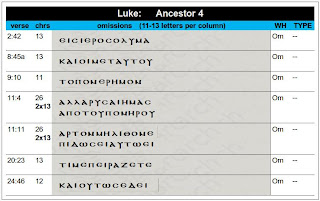First off, we may note the remarkable coincidence in multiples of line-length with the largest omissions:
 | |||
| Click to Enlarge: Backbutton to return |
Now consider the widest column-widths as likely to be the most ancient, and we can put the stages of accumulation of omissions in a sensible order:
Again, with the wider columns, there is more variation in letter-counts, so that we cannot be sure if we have three different exemplars and their omissions, or if these could have all occurred in the work of a single copyist from a single exemplar. However, the sheer number of omissions suggests that this is an accumulation from several copying generations.
Again, these very popular column-widths argue strongly for exemplars with this style of column, and place the omissions in the early to mid 3rd century.
Finally, we have the left-overs: Short omissions that could have actually happened at any time, and are unlikely to involve column-widths as a partial cause. These skips were probably accomplished alone the same line, rather than as a skip to the next line down.
Conclusion:
Again, the best interpretation of the column-format evidence is that there were between 4 and 6 generations of copying plagued by poor correction between the earliest copy of Luke and the closest common ancestor of Aleph/B.
Thus, the common omissions of Aleph/B, far from indicating the same source (i.e., a 'pure', Neutral text), clearly indicate different origins, but similar causes, and therefore, must involve many errors in transcription, building up over several copying generations.
It is ironic but true, that although these omissions can sometimes indeed be traced several generations earlier than their popular representatives (Aleph/B), they remain errors. They bring us no closer to the original text than any similar set of early haplography errors would, built up during that period of wilder copying and less systematic proof-reading that obviously took place in the late 2nd and early 3rd century.
Nor can the text(s) constructed from such clumsy readings really take us any further back than the late 2nd or early 3rd century, when these mistakes arose in great numbers, in the Alexandrian stream of transmission.
mr.scrivener








No comments:
Post a Comment